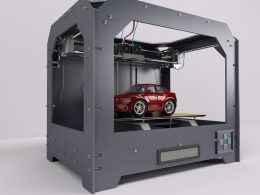What is IoT in Manufacturing and How to Use It
The Internet of Things (IoT) is no longer just a concept of the future but a transformative force in industries worldwide, especially in manufacturing. By connecting devices, machines, and systems through the internet, IoT in manufacturing is driving efficiency, reducing costs, and optimizing operations. This article will dive deep into the use of IoT in manufacturing, exploring its benefits, applications, and real-world examples.
Understanding IoT in Manufacturing
IoT, or the Internet of Things, refers to the network of interconnected devices equipped with sensors, software, and other technologies to collect and exchange data over the internet. In smart manufacturing, IoT is revolutionizing production processes by providing real-time insights, improving machine efficiency, and enabling better decision-making.
How Does IoT Work in Manufacturing?
At its core, IoT manufacturing systems rely on sensors and devices embedded in machinery, products, and other manufacturing components. These devices collect data from different stages of the production cycle, enabling manufacturers to monitor operations, predict equipment failures, and streamline production lines.
For instance, machine monitoring with IoT allows manufacturers to track performance metrics such as energy consumption, wear and tear, and production speed. Data collected from these sensors are then sent to the cloud or local servers, where analytics tools process them in real time to improve efficiency.
Key Benefits of IoT in Manufacturing
Implementing IoT solutions in manufacturing offers several advantages. Below are the key benefits of IoT in manufacturing:
1. Increased Efficiency and Productivity
IoT enables manufacturers to monitor production processes more closely, identifying inefficiencies in real time. With access to real-time data in manufacturing, managers can make informed decisions to optimize machine usage, reduce bottlenecks, and improve overall workflow.
For example, Harley-Davidson reconfigured its manufacturing facilities using IoT systems, reducing the production time for motorcycles from three weeks to just six hours. This remarkable improvement in productivity demonstrates the power of IoT-driven efficiency.
2. Predictive Maintenance
One of the most significant trends in IoT manufacturing is predictive maintenance. By using IoT sensors to monitor machine health, manufacturers can predict when equipment will need servicing, reducing downtime and preventing costly repairs.
For instance, General Electric (GE) employs IoT to monitor its jet engine manufacturing process. The sensors track the engines’ performance, enabling GE to forecast when maintenance is needed and avoid disruptions in production.
3. Better Quality Control
IoT improves quality control by allowing manufacturers to monitor product quality at every stage of production. Real-time data enables quick identification of defects, ensuring that problems are corrected before they escalate.
Philips, a global electronics company, uses IoT to monitor its production process and detect quality issues early, resulting in better product design and fewer recalls.
4. Enhanced Supply Chain Visibility
With IoT, manufacturers gain greater visibility into the supply chain. By tracking materials and products in real time, companies can avoid inventory shortages, streamline logistics, and reduce waste.
BMW leverages IoT to track vehicles in production, ensuring smooth coordination between different stages of the manufacturing process, ultimately minimizing production delays.
5. Improved Worker Safety

Another significant benefit of IoT in manufacturing is improved worker safety. By monitoring working conditions and machinery status, IoT systems can alert management to potential hazards. If a machine is malfunctioning or an environment becomes unsafe, an automated alert can prevent accidents before they occur.
Owens Corning, a building materials manufacturer, uses IoT to track safety data, ensuring that employees operate in safe conditions and reducing workplace accidents.
6. Cost Reduction
IoT helps reduce manufacturing costs by improving production efficiency, reducing downtime, and minimizing waste. Manufacturers can use real-time data to manage resources effectively, order materials before shortages occur, and cut operational costs.
By incorporating IoT manufacturing systems, companies can better control production costs and increase profitability, making it an essential investment in today’s competitive market.
Real-World Applications of IoT in Manufacturing
Now that we’ve discussed the benefits, let’s look at specific applications of IoT in manufacturing:
1. Mass Customization
IoT plays a crucial role in enabling mass customization, where manufacturers tailor products to meet individual customer preferences. Sensors gather real-time data from customers and integrate it into the production process, allowing companies to produce personalized items without compromising efficiency.
Cimpress, known for its customized print products, uses IoT-based software to deliver personalized apparel and products efficiently.
2. Edge Computing in Manufacturing
Edge computing in manufacturing refers to processing data closer to where it is generated, rather than sending it to a distant cloud server. This setup reduces latency, enabling real-time decision-making and faster response times. In manufacturing environments where timing is critical, edge computing improves operational efficiency by allowing quicker data processing and action.
3. Supply Chain Management
IoT enhances supply chain management by providing real-time visibility into inventory, transportation, and delivery stages. Companies can track raw materials, monitor stock levels, and ensure timely delivery of finished goods.
Amazon, for example, integrates IoT into its logistics and supply chain systems, enabling real-time tracking of packages and improving delivery accuracy.
4. 5G in Manufacturing
The introduction of 5G in manufacturing offers faster internet speeds and lower latency, revolutionizing IoT applications. With 5G connectivity, manufacturers can collect, analyze, and act on data faster, improving the efficiency of smart factories and enabling advanced applications like automation and robotics.
Challenges of IoT in Manufacturing
While IoT offers many advantages, its adoption is not without challenges. Below are some of the main IoT challenges in manufacturing:
1. Security Concerns
Since IoT devices rely heavily on internet connectivity and cloud storage, there are significant security concerns regarding potential data breaches. Hackers could exploit vulnerabilities in the system, compromising sensitive production data or intellectual property. To combat this, manufacturers must invest in robust cybersecurity measures to safeguard their IoT networks.
2. Data Overload
IoT systems generate massive amounts of data, which can be overwhelming for manufacturers. Managing, analyzing, and making sense of this data requires advanced analytics tools and skilled personnel, which can be resource-intensive.
3. Implementation Costs
The initial investment required for IoT implementation, including hardware, software, and staff training, can be high. Manufacturers need to assess the long-term ROI to ensure the system will benefit their business.
4. Change Management
Introducing IoT into a traditional manufacturing environment can meet resistance from employees. Successful IoT adoption requires effective change management, including comprehensive employee training and communication.
Trends Shaping the Future of IoT in Manufacturing

As technology continues to evolve, several trends are shaping the future of IoT in manufacturing:
1. Predictive Maintenance
As mentioned earlier, predictive maintenance is one of the most promising applications of IoT. With smart sensors and data analytics, manufacturers can anticipate equipment failures and schedule maintenance proactively, avoiding costly downtime.
2. Blockchain
Blockchain technology offers a secure and transparent way to track and store data, making it ideal for supply chain management in manufacturing. Blockchain can provide real-time insights into inventory levels, shipment status, and product authenticity, helping manufacturers improve trust and collaboration with partners.
3. Augmented Reality (AR)
AR is another technology transforming manufacturing by providing real-time instructions and information to operators. With AR, workers can visualize complex procedures, reducing training time and improving accuracy on the production floor.
Case Studies of IoT in Manufacturing
Let’s explore some well-known examples of companies utilizing IoT in manufacturing:
- General Electric (GE): GE uses IoT to monitor jet engine performance, helping to enhance design and maintenance processes. By collecting and analyzing engine data, GE improves the efficiency and safety of its products.
- BMW: The automotive giant leverages IoT to track vehicles throughout production, allowing for better inventory management and reduced production delays.
- Philips: Philips employs IoT to monitor quality control during production. By catching defects early, they can ensure that high-quality products reach the market.
Conclusion
IoT in manufacturing is not just a futuristic concept; it is an essential component of modern industrial practices. From predictive maintenance to quality control, IoT offers manufacturers unparalleled insights and opportunities for optimization. While challenges like security concerns and implementation costs remain, the benefits—increased efficiency, reduced downtime, and better safety—far outweigh the risks.
As more manufacturers embrace IoT manufacturing systems, the future of production will be smarter, faster, and more efficient than ever before. With the continuous advancements in 5G, edge computing, and blockchain, IoT’s role in manufacturing will only grow, transforming industries worldwide.










